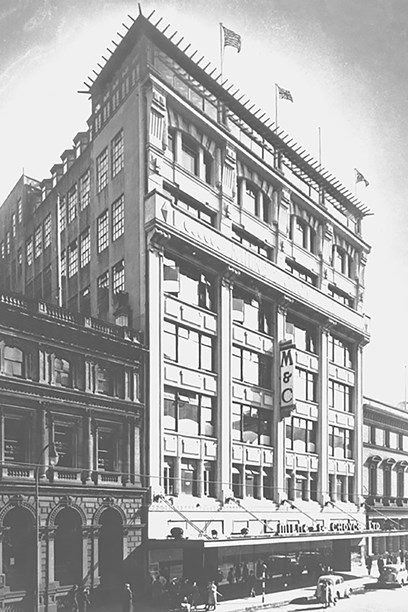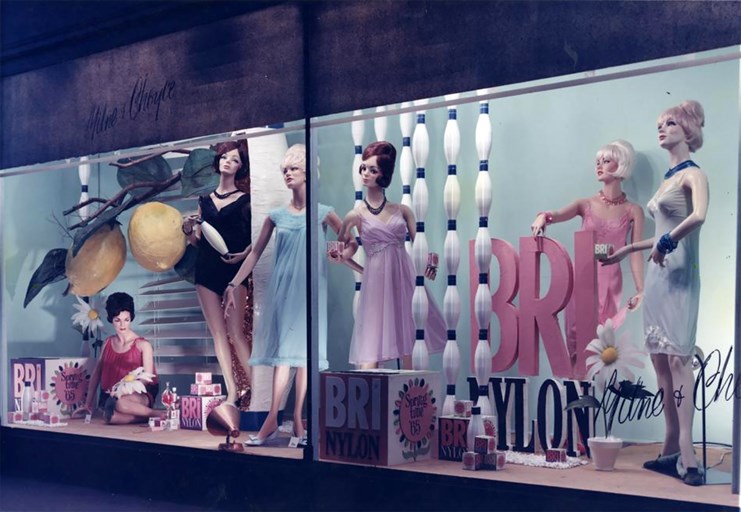Stories
Milne & Choyce
1867-1999

Auckland in the 1950s was served by five major department stores. The first of these to be established, and a pioneer in supplying Aucklanders with the latest fashions, was Milne & Choyce on Queen Street.
In 1863 the Milne family, consisting of parents John and Margery, their three sons and two daughters, arrived in Auckland from Northern Ireland. Four years later, on 3 July 1867, the two sisters Mary Jane and Charlotte - known as the Misses Milne - took over a small drapery shop at 37 Wyndham Street, on the corner of Albert Street.

Mary Jane and Charlotte Milne.
Despite challenges faced by their new venture such as its location - some distance from Auckland’s main shopping area in Shortland and Queen Streets - and competition from several other established drapery stores, the business flourished. In the early 1870s the Misses Milne advertised a wide-ranging stock of fashionable lines such as millinery, straw goods, feathers, lace goods, headdresses and silk jackets, while their winter fashions included sealskin cloth, waterproof tweed, and furs in sable and ermine. In addition, they always carried a large stock of mourning material.
In 1874 they moved to larger rented premises in Queen Street, on the corner of Wellesley Street. That same year Charlotte married Henry Charles Choyce, who had arrived in New Zealand from Leicestershire in 1866. In 1876 he took over Charlotte’s interest in the business and the new partnership was named Milne & Choyce.
Business continued to grow in the Queen Street premises with Milne & Choyce claiming to have the largest stock in Auckland. In addition to millinery, the store had established additional departments for jackets and mantles (sleeveless cloaks), hosiery, umbrellas and sunshades, gloves, dresses, silk and manchester, as well as underclothing, baby linen and boys’ clothing.
In 1887, just as New Zealand was entering a depression, Milne & Choyce offered a distraction from the gloomy outlook with a spring fashion parade, perhaps one of the first events of its kind in Auckland. When the new cycling craze arrived early in the following decade enthusiasts were able to obtain the necessary garments from Milne & Choyce.

Milne & Choyce hat box, circa 1900. Image courtesy of Auckland War Memorial Museum 1995.56.21.
In 1901 the business became the public company of Milne & Choyce Ltd., and seven years later it was on the move again, to a prime location "between the banks" at 131-141 Queen Street. By 1926 the existing wooden premises had been replaced by what an enthusiastic Auckland Star described as 'a magnificent building' which would 'rank with the finest establishments of the kind anywhere in the world'.

The premises of Milne & Choyce at 131-141 Queen Street, Auckland, 1948. Image by Sparrow Industrial Pictures Ltd, courtesy of Auckland War Memorial Museum Tāmaki Paenga Hira, PH-NEG-SP-4667.
Designed by Auckland architect Llewellyn Piper, the new nine-storeyed structure (which included to two floors below street level, now both carparks) claimed 'six spacious and swift elevators, vigilant fire alarms and a private telephone exchange', while the third-floor millinery and apparel department was distinguished by 'an immense Axminster carpet, of beautiful quality'.
A new fashion showroom was opened in 1940. Images courtesy of Auckland War Memorial Museum Tāmaki Paenga Hira, PH-ALB-575.
Milne & Choyce's large workroom, which custom-made and fitted garments for their clients, was in the Queen Street building at this stage. They also produced their own in-house labels. By the 1950s the workroom was located off-site in Parnell, and a second workroom was based in the Maida Vale premises in New North Road - a company that Milne & Choyce had acquired in 1946.

The Milne & Choyce fashion workroom, 1941. Photo by Arthur Sparrow and Cecil Bostock, courtesy of Auckland War Memorial Museum Tāmaki Paenga Hira.
In October 1947, some 60 years after its first fashion show, Milne & Choyce presented a parade of 70 original Paris fashions. This was the first time such garments had been seen in Auckland for the season for which they were designed, and it was also the first opportunity New Zealanders had to buy copies of the latest fashions. The collection was valued at £35,000, and among the designers represented were Christian Dior - who had just taken Paris by storm - and Balenciaga.
The parade was a gala event, enjoyed by a large audience of invited guests and extensively covered in the media. It was presented in the store’s tearoom, the Tudor Room, which was given a Parisian makeover for the occasion. The mannequins emerged from a model of the Eiffel Tower and strutted down a catwalk which evoked the Champs Elysees, with a border of trees and awnings bearing the names of cafés.
The show opened with leisure wear, which included the 'sloppily comfortable' clothes then becoming popular with American teenagers. Some of the skirts shown followed the slightly longer and very fashionable 'London Line', while many garments featured the nipped-in 'hourglass silhouette', reflecting the new feminine trend of rounded hips and shoulders.
Predictably, black was a popular colour, while there were also pastels, off-whites, a deep storm cloud grey, and a new tone identified as toast brown. On a practical level, it was pointed out that there were few formal occasions where Aucklanders could wear such magnificent garments. Another obvious problem was that Dior’s swinging pleats and padded hips would make his creations difficult to wear in Auckland’s small cars.
In 1946 Milne & Choyce had acquired an existing business, the Maida Vale Clothing Company, as a means of dealing with the difficulty of obtaining import licences and to cater to the demand for the latest fashion which needed to be manufactured locally. In premises in New North Road and Dominion Road, Maida Vale produced menswear and womenswear under such labels as Chesterton and Deauville. They also maintained a large workroom that made to order and they had their own in-house designers, including Bruce Papas, who interpreted the latest trends for the stores own brand. The Milne & Choyce seasonal window displays were eagerly anticipated and drew crowds from all over Auckland and on occasion required traffic control to move people along.
In 1955, four Italian models took part in Milne & Choyce parades in Auckland and Hamilton alongside local models including Else van den Muysenbergh and Bobby Jarvis. Promoted as 'Italy at Milne & Choyce', it was a show of original Italian fashions and created great excitement.

In 1955 the promotion 'Italy at Milne & Choyce' included fashion paraded by four Italian models. Image from the Auckland Star, 1955.
Modernisation at Milne & Choyce included the installation of Queen Street’s first escalator in 1958. About the same time the store responded to that new social phenomenon, teenagers, by introducing a "Miss" department. The company opened its first branch store, at Hamilton, in 1950, and followed this with another in Palmerston North. But the nation’s shopping patterns were undergoing dramatic changes, as reflected by the rapid growth of suburban areas, so Milne & Choyce establishing branches at Takapuna, Mt Roskill, Panmure, Remuera, Mangere and in 1963 became a foundation store at the newly opened Lynnmall in New Lynn.

A 1960s window display by Allan Smith at Milne & Choyce in Palmerston North. The mannequins are wearing Bri Nylon underwear and nightwear. Photo by Barry Woods, courtesy of Ian Matheson City Archives, Manawatū Heritage, Palmerston North Libraries and Community Service.
To celebrate 100 years of business, in August 1966 Milne & Choyce presented a historic display upstairs in its Queen Street store. This popular attraction subsequently became the Centennial Street exhibit at the Auckland War Memorial Museum, where it was later renamed 'Auckland 1866' before being finally closed and dismantled in 2015.
In the 1970s a controlling share of Milne & Choyce was bought by Fletcher Holdings, and the name Milne & Choyce changed to Milnes when the retail stores were taken over by Haywrights (who were later taken over by Farmers). The flagship Queen Street store closed in 1976, and while the renamed Milnes of Remuera lingered on, it was also sold in the 1990s, thereby marking the end of a lengthy and illustrious chapter in the history of retailing in Auckland.
Text by Richard Wolfe.
Last published July 2017.